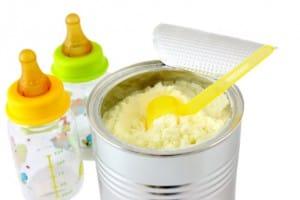
The Best Formula for Your Baby
“Congratulations on your new baby! Are you going to breastfeed or use formula?” This is a question every mother is asked. Never before has someone so quickly asked you a question so personal.

The American Academy of Pediatrics (AAP) joins other organizations such as the American Medical Association (AMA), the American Dietetic Association (ADA) and the World Health Organization (WHO) in recommending breastfeeding as the best for babies. Breastfeeding helps defend against infections, prevent allergies and protect against a number of chronic conditions. But breastfeeding doesn’t always work for everyone.
There are a lot of reasons why a mother chooses not to breastfeed. If you choose not to breastfeed, it is important not to feel guilty. You should also know about the other options. A few things to think about: what type of formula is best for your baby? What is more convenient to find? What can you afford?
Formula for success
Do you ever wonder why you give your baby a specific type of formula? Did you just use the same formula you used for your other child? Was the formula recommended by your pediatrician, a family member or a friend? Or was it simply the most affordable?
The AAP recommends that all infants be fed breast milk or iron-fortified formula for at least 12 months.
Amanda Reyes, lactation consultant at Children’s Hospital Los Angeles, explains how it is very difficult for mothers to reach the goal of breastfeeding exclusively for the first six months. Many barriers outside of the mother’s control present challenges to breastfeeding. When mothers encounter those barriers, they often feel they have no place to turn and, feeling unsuccessful, reach for the formula to nourish their child. If this sounds familiar, I encourage you to reach out to a Board-certified lactation consultant to provide support and work with you to overcome your barrier. Reyes provided a great link that explains the difference between formula and breast milk.
Baby formula is a balance of proteins, fats and carbohydrates, as well as micronutrients. Most baby formulas have a cow's milk base. There are soy-based formulas available for babies with very mild IgE-mediated allergies to milk, or whose parents wish to give them a diet free of animal protein. For babies who are allergic to both milk- and soy-based formulas, there are hypoallergenic formulas with finely broken-down proteins.

Eyal Ben-Isaac, MD, pediatrician and director of the Pediatric Residency Program at Children’s Hospital Los Angeles, explains: “Choices on the type of formulas (other than basic standard formulas) should be made in consultation with your pediatrician. Standard formulas contain casein and whey protein, as well as lactose, for their carbohydrate component. There are special formulas that are lactose-free, and some that thicken once in the baby’s stomach to help with gastro-esophageal reflux.”
If your child has allergies, colic, reflux symptoms or gastrointestinal issues, your pediatrician can help you decide on the best formula for the baby. Infant formula is available in two forms:
- Liquid infant formula, sold in cartons, is sterile. It comes in concentrated liquid form to which you add appropriate amount of water, and are ready to feed.
- Powdered infant formula is the least expensive and not sterile. You add water to this as well.
Feeding babies milk is not the same as giving them formula. Not all milk is suitable for babies. You should never give the following types of milk to a baby under 1 year of age:
- Condensed milk
- Evaporated milk
- Dried milk
- Sheep's milk
- Goat’s milk
- Other types of drinks known as "milks," such as rice, oat or almond drinks
- Cow’s milk as a drink—but it's fine to use it when cooking for your baby after you’ve started introducing them to solid foods
There are programs such as the Special Supplemental Nutrition Program for Women, Infants and Children (WIC) that will assist you with your nutrition if you are breastfeeding or formula-feeding your baby. WIC provides grants to states for supplemental foods, health care referrals, and nutrition education for low-income pregnant, breastfeeding and non-breastfeeding women, and to infants and children up to age 5 who are found to be at nutritional risk. Find out more information about WIC.


